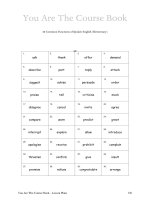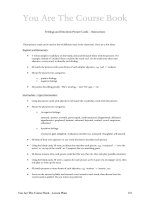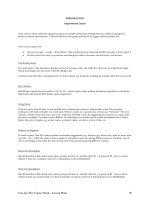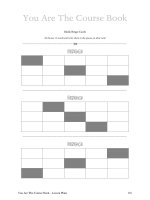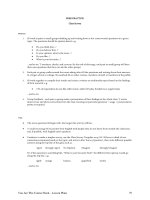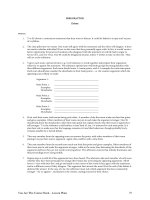yatcb lesson plans stress reduce merge part 2 connected speech
Bạn đang xem bản rút gọn của tài liệu. Xem và tải ngay bản đầy đủ của tài liệu tại đây (49.71 KB, 2 trang )
PRONUNCIATION
Stress, Reduce, Merge Part 2 – Connected Speech
Method:
1.
T or SS write 3 or 4 sentences on the board, with not too many syllables in each – 8-10 will do fine. There
should be space between them so there is room to write above and below each one. They could be from
the SS’s work or from a real text. SS copy them into their notebooks. T models each sentence and SS
repeat – as a group and individually.
2.
T asks one student to come to the board. T asks the SS to break a sentence up into syllables. They could
draw lines between the syllables, or rewrite the sentence in syllables. T checks that it is correct with the
whole group.
3.
T elicits the sequence of stressed syllables from the group, and SS marks them.
4.
T elicits the stressed vowel sound on each stressed syllable from the group, and SS marks them with Clear
Alphabet. This is the ‘Sound Spine’ – the sequence of the most important sounds in the sentence, which
must be heard clearly to convey meaning.
5.
T asks SS to focus on the weak syllables and elicits whether any of them can be combined with
contractions. SS changes the syllables on the board accordingly.
6.
T elicits the sound connections between the syllables, and SS marks them:
VC
F
CV
VV
CC
vowel sound to consonant sound
friendly connection (first syllable ends with m, n, ng, or l sound)
consonant sound to vowel sound
vowel sound to vowel sound
consonant sound to consonant sound
7.
T asks SS to circle VC and F connections. T elicits that VC and F connections are good because they are
easy to pronounce.
8.
T asks SS to look at the remaining ‘bad’ sound connections with their group or partner. SS should think
about the ‘Features of Connected Speech’ 1 and what we can do to ‘iron out’ the bad connections and make
them easier to pronounce. T may need to elicit or explain:
VC & F we don’t need to change them – they are already easy to pronounce
CV
FINAL CONSONANT LINKING (FCL): we usually move the consonant sound forward to join
the next syllable
VV
INTRUSION: we usually add a consonant sound: w, y, or r
CC
we have three options:
i.
FCL: move the first consonant sound forward; if voiced, it changes to unvoiced, e.g. b
changes to p (this is called ASSIMILATION)
ii.
ELISION: delete the first consonant sound; if it is t or d we could replace it with a
glottal stop
iii.
ASSIMILATION: the first consonant sound changes to make the phrase easier to say
SS sound out the phrases and the whole sentence as they do this work. T monitors, checks, and corrects,
then leads group feedback about the decisions taken to make the syllables fit together – to make the
sentence easy to pronounce and sound natural.
9.
SS write out the sentence – syllable by syllable – using Clear Alphabet. T monitors, checks, and corrects,
then leads group feedback.
1 Purland, Matt. Talk a Lot Foundation Course. Ostróda: English Banana.com, 2011. Hardback. Available for free download:
p.4.2
You Are The Course Book – Lesson Plans
70
10. SS repeat the process in their groups with one or all of the remaining sentences – depending on time
allocated. T monitors, checks, and corrects. Group feedback at the end. T elicits the main pronunciation
point: “So what have we learned from this...?”
Tips:
•
Wait until SS are confident using the method in Stress, Reduce, Merge Part 1 – Sentence Stress (p.69)
before running this session.
•
SS should be familiar with writing sentences phonetically with Clear Alphabet before running this session,
or T could model the Clear Alphabet text on the board and SS learn it by practising during a few of these
sessions.
•
For further information about the Stress, Reduce, Merge process, see Talk a Lot Foundation Course and
Stress, Reduce, Merge 2.
Purland, Matt. Stress, Reduce, Merge. Ostróda: English Banana.com, 2012. Material pack. Available for free download:
/>2
You Are The Course Book – Lesson Plans
71
